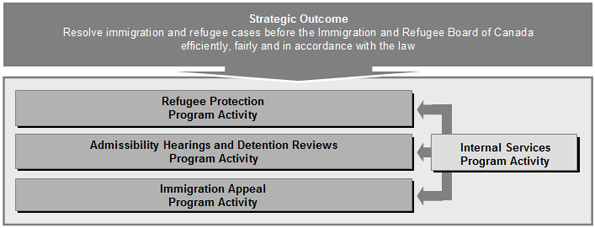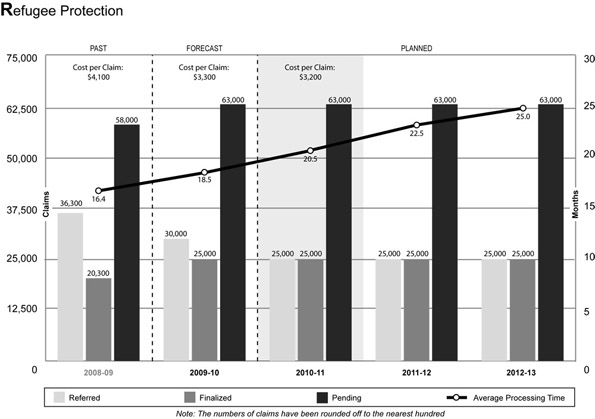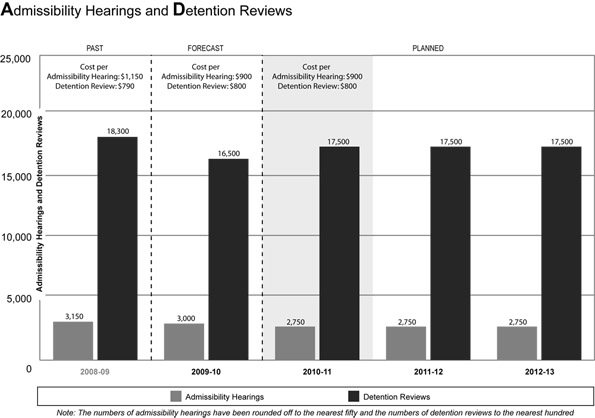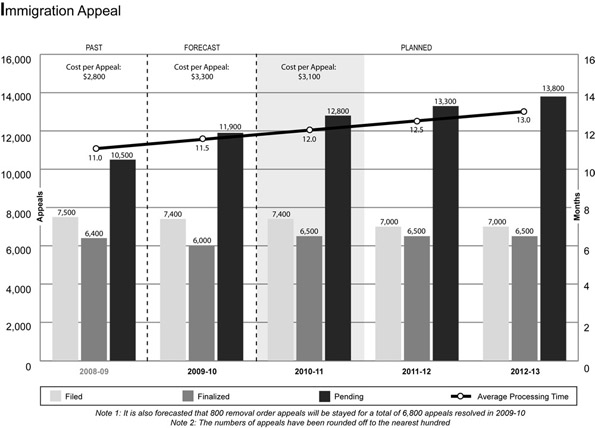Common menu bar links
Breadcrumb Trail
ARCHIVED - Immigration and Refugee Board of Canada
 This page has been archived.
This page has been archived.
Archived Content
Information identified as archived on the Web is for reference, research or recordkeeping purposes. It has not been altered or updated after the date of archiving. Web pages that are archived on the Web are not subject to the Government of Canada Web Standards. As per the Communications Policy of the Government of Canada, you can request alternate formats on the "Contact Us" page.
Section II – Analysis of Program Activities
This section provides detailed information on the plans and expected results as well as financial and human resources for the IRB's four program activities.
Strategic Outcome and Program Activities
As discussed in Section I, based on the IRB's legislated mandate and approved PAA, the IRB has a single strategic outcome and three program activities that include responsibility for all tribunal decisions and resolutions. These are supported by Internal Services, which is the fourth program activity.

IRB program activities are designed to support the achievement of the strategic outcome. The following pages further describe these program activities, identifying expected results, performance indicators and targets, as well as outlining the resources dedicated to each of the four activities.
Program Activity 1: Refugee Protection
The Refugee Protection Division (RPD) delivers the IRB's Refugee Protection program activity. It determines claims for refugee protection made in Canada. Processing of refugee claims is the main focus of the IRB's activities and resources. Through the work of the RPD, Canada fulfils its obligations as a signatory to a number of international human rights conventions.
Additional information on the RPD is available at
http://www.irb-cisr.gc.ca/eng/tribunal/rpdspr/pages/index.aspx
| Human Resources (FTEs) and Planned Spending ($ Millions) | |||||
|---|---|---|---|---|---|
| 2010-11 | 2011-12 | 2012-13 | |||
| FTEs | Planned Spending | FTEs | Planned Spending | FTEs | Planned Spending |
| 565 | 57.9 | 565 | 57.8 | 565 | 57.8 |
| Expected Result | |
|---|---|
| Quality decisions rendered and cases resolved in a timely manner regarding refugee protection claims made in Canada | |
| Performance Indicators | Targets |
| Clarity, completeness and conciseness of IRB reasons for decisions | Target under development at the time of publishing this report. |
| Percentage of cases finalized without a hearing | It is expected that 6 to 8% of cases will meet the criteria to be finalized without a hearing, through more expeditious processes. |
| Ratio of finalized cases to referred cases | Approximately 25,000 refugee protection claim referrals are expected to be received in 2010-11. Because it is assumed that the RPD will be at its funded decision-maker complement for the fiscal year, finalizations are expected to be 25,000 claims. This will result in a ratio of finalized-to-referred cases of 100%. |
| Average cost per claim finalized | $3,200 |
| Average case processing time | The average processing time (from referral to finalization) could increase to 20.5 months as the age of the cases in the inventory continues to grow. |
2010-11 Planning Highlights
Decision-makers. At the time of the writing of this report, it is expected that the RPD will be very close to its full complement of decision-makers by the beginning of 2010-11. This represents a marked change from the previous two fiscal years, throughout which there were significant vacancies in the RPD's decision-making complement. However, active recruitment will remain a priority activity for the Board as 28 decision-makers will reach the end of their mandate during 2010-11. Any delay in the timely reappointment or replacement of decision-makers at the end of their mandates will have an impact on the Division's productivity. Moreover, with 68 percent of decision-makers in their first mandate, effective, timely and tailored training remains a priority for the IRB.
Inventory. There will be 63,000 refugee protection claims waiting to be heard by the beginning of 2010-11. This accumulated inventory is well beyond the Division's capacity to address within existing resource levels. For 2010-11, referrals and finalizations are expected to become fairly balanced (both at 25,000 claims), resulting in no further increase to the number of pending cases. Without additional resources, the accumulated inventory is expected to remain relatively unchanged by the end of the 2010-11 reporting period.
Case management. Case management efficiencies, including enhanced adjudicative support, continued hearing-readiness efforts, and more focused monitoring of postponements and adjournments, will allow productivity to remain high despite the fact that the majority of the decision-maker complement is relatively inexperienced.
Quality. During 2010-11, the RPD will continue to deliver fair and high-quality decisions and reasons. Quality improvements will come from clearly communicated performance standards and associated monitoring, appropriate use of videoconferencing and the increased use of recently implemented decision-making tools. In the year ahead, the RPD will continue to be an adaptive, integrated and flexible tribunal.
Benefits for Canadians
Through the work of the Refugee Protection program activity, Canada accepts only those refugee claimants who are in need of protection. Canada provides a safe haven to persons with a well-founded fear of persecution as well as to those facing a danger of torture or a risk to their life, or a risk of cruel and unusual treatment or punishment if returned to their country of origin. This contributes to a safe and secure world environment.
Program Activity 2: Admissibility Hearings and Detention Reviews
The Immigration Division (ID) delivers the Admissibility Hearings and Detention Reviews program activity. It holds hearings for foreign nationals or permanent residents who, under the provisions of the IRPA, are alleged to be inadmissible to Canada or are detained. Detainees must be seen by the ID within 48 hours after their referral, or without delay thereafter, and subsequent reviews must be conducted within specific statutory timeframes. Decision-makers must balance the right to individual liberty with the safety and security interests of Canadians.
Additional information on the ID is available at
http://www.irb-cisr.gc.ca/eng/tribunal/idsi/pages/index.aspx
| Human Resources (FTEs) and Planned Spending ($ Millions) | |||||
|---|---|---|---|---|---|
| 2010-11 | 2011-12 | 2012-13 | |||
| FTEs | Planned Spending | FTEs | Planned Spending | FTEs | Planned Spending |
| 70 | 12.7 | 70 | 12.7 | 70 | 12.7 |
| Expected Result | |
|---|---|
| Quality decisions rendered and cases resolved in a timely manner regarding admissibility hearings and detention reviews | |
| Performance Indicators | Targets |
| Clarity, completeness and conciseness of IRB reasons for decisions | Target under development at the time of publishing this report. |
| Percentage of admissibility hearing cases concluded to referred cases | 98% (Detention reviews take priority over admissibility hearings due to legislative time requirements. The number of referrals from the CBSA affects the capacity to conduct admissibility hearings.) |
| Percentage of concluded detention review cases within statutory timeframe | 97% (Factors outside the IRB's control, such as prison lock-downs, impede the achievement of 100% compliance.) |
| Average cost of admissibility hearing | $900 |
| Average cost of detention review | $800 |
| Percentage of admissibility hearings concluded with a hearing within six months from referral | 88% (The number of detention review referrals from the CBSA and the complexity of a growing number of cases affect the capacity to conclude admissibility hearings within the six-month target.) |
2010-11 Planning Highlights
Sustained and more complex workload. The number of cases concluded by the ID depends largely on the number of cases referred by the CBSA. Over the past three years, referrals for admissibility hearings have increased by 27 percent while referrals for detention reviews have increased by 4 percent. In addition, a growing number of admissibility hearings involve more complex and novel issues. However, through continued efficiencies, the ID has increased its output within existing resources and has been able to conclude cases within the legislated timeframe for detention reviews.
During 2010-11, it is anticipated that the ID will continue to experience a moderate decrease in referrals for admissibility hearings while the number of detention reviews will remain high but stable. The ID will continue to prioritize detention reviews to ensure that legislative requirements and fundamental rights are respected.
Effective case management. In order to manage its case inventory, the ID will monitor its scheduling standards to ensure that determined productivity targets are being met. The further enhancements of effective case management practices will allow the ID to maintain reduced adjournment and postponement rates, to reduce processing times, and to increase its capacity to resolve cases in a timely fashion. A sample of decisions will also be selected for quality review; the results of this review will serve to improve and refine training programs.
More focused monitoring of efficiency standards will allow the Division to reduce the number of admissibility hearings that are pending for more than six months and finalize the vast majority of new cases within a six-month timeframe.
Through ongoing communication and effective management, the ID will foster a work environment that builds on the individual skills and talents of its people.
Benefits for Canadians
The ID renders decisions that maintain the security of Canadian society and uphold Canada's reputation for justice and fairness to individuals. Through its work on admissibility hearings and detention reviews, the ID contributes to the maintenance of the balance between individual rights and the safety and security of Canadians.
Program Activity 3: Immigration Appeal
The Immigration Appeal Division (IAD) delivers the Immigration Appeal program activity. It hears immigration appeals from Canadian citizens and permanent residents whose applications to sponsor close family members to Canada have been refused. Other key functions include hearing appeals from permanent residents, foreign nationals with a permanent resident visa, protected persons who have been ordered removed from Canada, and permanent residents outside Canada who are alleged to have not fulfilled their residency obligation.
Additional information on the IAD is available at
http://www.irb-cisr.gc.ca/eng/tribunal/iadsai/pages/index.aspx
| Human Resources (FTEs) and Planned Spending ($ Millions) | |||||
|---|---|---|---|---|---|
| 2010-11 | 2011-12 | 2012-13 | |||
| FTEs | Planned Spending | FTEs | Planned Spending | FTEs | Planned Spending |
| 120 | 14.6 | 120 | 14.6 | 120 | 14.6 |
| Expected Result | |
|---|---|
| Quality decisions rendered and cases resolved in a timely manner regarding immigration appeals | |
| Performance Indicators | Targets |
| Clarity, completeness and conciseness of IRB reasons for decisions | Target under development at the time of publishing this report. |
| Percentage of appeals finalized without a hearing | It is expected that 43% or more appeals will be finalized without a hearing. |
| Ratio of finalized appeals to filed appeals | Approximately 7,400 appeals are expected to be filed in 2010-11. Based on the number of decision-makers available, we expect to finalize 6,500 appeals. This will result in a ratio of finalized-to-filed appeals of 88%. |
| Average cost per appeal finalized | $3,100 |
| Average appeal processing time | Based on the inventory, it is expected that the average processing time could increase to 12 months in 2010-11. |
2010-11 Planning Highlights
Decision-makers. In 2010-11, the IAD expects to be close to its full complement of decision-makers. Despite the fact that the majority of IAD decision-makers will be in their first mandate, with several in their initial training period, the Division expects to achieve a high level of productivity.
Inventory. The IAD is forecasting an intake of 7,400 filed appeals for 2010-11. The inventory of appeals awaiting finalization will increase slightly to 12,800. The Division will continue to identify efficiencies in its procedural, adjudicative and administrative practices and, as new decision-makers become more experienced, productivity will increase.
Case management. The IAD will continue to respond in a flexible manner to match resources with regional caseloads by sharing decision-makers among regions and by conducting hearings via videoconference where appropriate. Case management strategies will focus on increasing early resolution of appeals without a hearing, enhancing hearing readiness, scheduling appeals strategically to increase efficiencies, and monitoring reasons for postponements and adjournments. The IAD remains committed to producing quality decisions that are made in a timely manner.
Portfolio linkages. The IAD will continue to work with the CBSA to quickly finalize appeals that the CBSA has screened for early resolution and to facilitate the hearing of appeals where the Minister's counsel has chosen to participate through written submissions only. Work undertaken with the CBSA on case management innovations will continue, as always, to respect the adjudicative independence of IAD decision-makers.
Benefits for Canadians
Through its sponsorship appeals work, the IAD recognizes the contributions of immigrants to the strength and vitality of Canadian society and culture, as well as the Government's commitment to family reunification. Through its work on removal order appeals, the IAD enhances public safety while ensuring that individuals' fundamental rights are respected.
Program Activity 4: Internal Services
Internal Services are groups of related activities and resources required to support the needs of all three tribunal programs and other corporate obligations of the IRB. These services are: Management and Oversight; Communications; Legal; Human Resources Management; Financial Management; Information Management; Information Technology; Materiel; Acquisition; and Other Administrative Services. Internal Services include only those activities and resources that apply across an organization and not to those provided to a specific program.
| Human Resources (FTEs) and Planned Spending ($ Millions) | |||||
|---|---|---|---|---|---|
| 2010-11 | 2011-12 | 2012-13 | |||
| FTEs | Planned Spending | FTEs | Planned Spending | FTEs | Planned Spending |
| 270 | 31.9 | 270 | 31.8 | 270 | 31.8 |
2010-11 Planning Highlights
Management and oversight. During 2010-11, the IRB will focus on two specific areas of management and oversight: staffing of human resources and oversight of systems development:
- As a result of the Public Service Commission (PSC) audit of the IRB's staffing activities, the Board recognizes that human resource management practices must be strengthened across the organization, particularly in the area of staffing, to ensure compliance with the Public Service Employment Act (PSEA), the PSC Appointment Framework and other governing authorities. This will involve a collective effort on the part of the entire management team to address the issues identified in the audit report in a rigorous, timely and transparent manner. We will also continue to develop monitoring frameworks in the areas of classification, staffing and compensation to identify and address areas for improvement.
- In October 2009, the IRB contracted with an outside firm to carry out an on-going independent review of the IRB's System for Tracking Appeals and Refugees (STAR) Modernization Project. The purpose of the review is to confirm that the IRB has a full and complete understanding of the project parameters, how work on the project will be undertaken, and the dependencies inherent in its successful completion. Independent reviewers from this outside firm will also serve as advisors to IRB senior management throughout 2010-11 and the life of the project.
Communications. The IRB will continue to engage with key partners, national and international stakeholders, and the public through its Outreach and Communications programs and international activities. Through its work in this area, the IRB will facilitate information sharing and enhance understanding of its mandate and operations to aid in implementing its key initiatives and priorities.
Legal. Legal Services will focus its activities on providing training and support to the large number of newly appointed decision-makers and offering advice, including risk analysis, regarding innovative adjudicative strategies and their implementation in support of the Board's inventory management. Legal Services will also continue to provide substantial support and advice on complex cases involving classified information related to national security or criminal intelligence. With the possibility of refugee reform, Legal Services will also ensure that any proposed new aspects of operations, service delivery, policy development, corporate direction and management decisions are in compliance with all relevant legal requirements.
Human resources management. The IRB fosters an environment where people management is valued and recognized as a priority in achieving its strategic outcome. During 2010-11, the IRB will continue to build its capacity to fulfil its human resources needs in a timely and effective manner. The Board will continue to act on the PSC's recommendations in the 2009 audit. The IRB is committed to conducting staffing activities which respect merit as well as the core and guiding values of the public service, in accordance with the PSEA.
Financial management. The IRB will focus its efforts on implementing the new suite of Treasury Board Secretariat (TBS) financial policies and directives including the Policy on Internal Control and its specific requirements related to financial reporting. These include impact analysis, amendments to existing internal processes and practices, development of new or amendments to existing directives and procedures, communications, and training.
Information management. The information management section will finish implementing the new IRB function-based classification structure. The role of the IRB Chief Information Officer (CIO) will be defined and the internal mechanisms that will support the CIO will be instituted.
Information technology. Information Technology (IT) at the IRB is shaped by new and emerging business priorities and on-going systems and infrastructure maintenance and upgrades. In 2010-11, IT efforts will focus on the successful release and implementation of the Interactive Scheduling Interface, a new scheduling tool for the RPD, and the effective and timely development of the STAR Modernization Project for the RPD and IAD.
Procurement and assets management. The IRB will continue to strengthen its procurement functions through the mandatory course Overview of Procurement offered by the Canada School of Public Service. We will improve internal processes to further eliminate duplication of effort. In addition, we will implement new green policies and procedures to ensure effective, efficient, accountable and environmentally-responsible activities related to the life-cycle management of the IRB's assets.
Internal audit. In 2009-10, the IRB's internal audit structure was reorganized to conform to the Treasury Board's Internal Audit Policy requirements. In 2010-11, a new internal audit policy will be developed as well as a three-year risk-based audit plan that reflects the IRB's changing environment. The newly established IRB Audit Committee will continue to strengthen its capacity and provide the Chairperson with objective advice and assurance on the adequacy of IRB's control and accountability processes.
Evaluation. The IRB is currently implementing key recommendations of a recent evaluation to improve the effectiveness and efficiency of its scheduling practices. At the same time, the IRB is laying the groundwork for its five-year departmental evaluation plan based on risk, evaluation needs and on the requirements set out by the TBS. This plan will expand the performance measurement framework to include indicators of decision-making quality and internal services.



